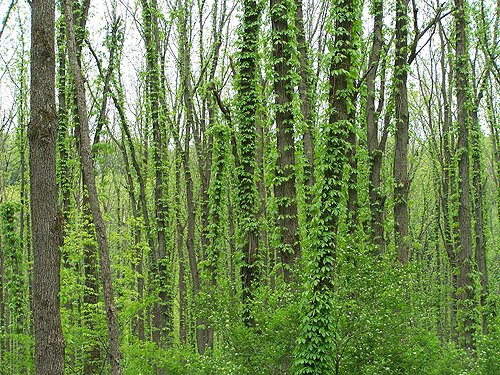Hedera, which we commonly refer to as English Ivy (pl. Ivies), is a family of around 20 species of evergreen perennial plants. Depending on their surroundings, these woody plants can be both ground creeping or climbing nearby trees, rocks, buildings, and pretty much anything they can lay their stems on.
Given a solid base, the ivy has the ability to crawl up and reach heights of more that 30m. On ground level it rarely exceeds ½ feet in height.
As gorgeous as this chef-d’œuvre of nature is, it can still cause mischief around your property if left unattended. It’s considered an invasive plant after all, meaning it’ll not knock on your door to ask if it’d be OK to crash in your yard for the night.

The Dark Side of Common Ivy
Now that you think of it, the ivy is quite the troublemaker. In addition to being an invasive plant which could potentially attach to and damage your property, it is also harmful to children and pets, causing allergic skin reactions from a mere touch, or vomiting if ingested.
The creeping and climbing habits of English Ivy pose a great menace to flowers and trees in your garden, stealing their essential nutrients and water. Its foliage blocks valuable sunlight from reaching other plants, and also creates shelter for different kinds of pests such as mice, rats, birds, bats, and insects. Ivy’s berries also attract wildlife, mostly birds, butterflies, moths, bees, and wasps.

How to Identify Poison Ivy
Nature is unique and it finds extraordinary methods to survive. One of them is for certain species to imitate a dangerous and poisonous lookalike. Poison ivy’s cousins don’t make an exception – there are, in fact, dozens of impostors. Some of the lookalikes are harmless, but others – such as poison sumac or poison oak, can cause even more pain and suffering. To identify the poison ivy plant you’ll need to:
Identify the plant’s leaves. Vines with leaves grouped in three are a telltale sign. This is definitely the most outstanding feature amongst all doppelgängers. Remember the catchphrase – “Leaves of three, let it be!“.
Check its growth pattern. Even though poison ivy bears the name of the type of plants that grow upwards only, it can spread in any direction. It also grows in bushes or as a single plant.
Mind the colour. Even though it is no longer green, poison ivy is still poisonous even in a reddish suit.
Identify fruits. Poison ivy has distinct white translucent fruits. As a matter of fact, poison oak has similar fruits, so either way, stay away.
https://www.thespruce.com/thmb/8WQz_7iKQLVvmfe2sHZX_I6gCWU=/450x0/filters:no_upscale():max_bytes(150000):strip_icc()/English-ivy-GettyImages-697631623-58b3b22a3df78cdcd8542175.jpg
How to Kill Ivy
Your best bet to completely eradicate invasive ivy involves the use of chemicals and about a month’s time for this method to take effect. Before you commence the process, be sure to have the following supplies at hand:
Rubber gardening gloves (£2 – £10)
Garden shears (£5 – £20)
Pruning saw for thicker ivy vines, if any (£10 – £20)
Spray bottle or sprayer (£10 – £20)
Weed killer of your choice (£20 – £30)
Long sleeves, long pants and boots (£5 – £20)
Strong patience (priceless)

Here are the steps to get rid of ground covering ivy:
Step 1. Find and mark all the plant’s base roots.
Step 2. Leave around 1-2 feet worth of ivy coming from the main roots untreated, for later.
Step 3. Start cutting the ivy in patterns, simultaneously pulling out each section.
Step 4. Pile up everything you’ve cut to dispose of it after the chemical treatment.
Step 5. Spray the freshly cut vines and remaining leaves (from Step 2) with a weed killer of your choice.
Step 6. Repeat this process every few weeks until the ivy is defeated for good.

Here’s how to kill climbing ivy on trees:
Step 1. Cut its vines at waist level 3-4 feet above tree trunk base with the garden shears, all around.
Step 2. Leave the ivy that remains on the tree to dry out and die off within a month or so. Do not pull the vines unless you’re sure they are dead. Otherwise you will damage the tree’s bark.
Step 3. Remove as much ivy roots as you can around the trunk by hand, leaving a safe zone of at least 3-4 feet radius. This way you can act fast if new ivy vines emerge.
Step 4. For what’s left on the ground, apply the same procedure as killing ground creeping ivy.
https://blog.fantasticgardeners.co.uk/how-to-get-rid-of-ivy/
magoo-2 found a series of multi accounts of a same owner is following your articles to cheat your generous rewards.
magoo-2 found these accounts are suspicious & can be multi accounts of a single owner. Conclusion is based on last 1 year transactions:
@jacqueline5
@african1
@merina
@marizanne
@miller1
@jerry1994
@aarshi
@nawmi
@maisha
@jenifer2
@masud1
@jerry2
@selina2
@bingham
@mulder2000
@umess
@neerose123
@diaa07
magoo-2
Check our latest multi comment spam update report
Downvoting a post can decrease pending rewards and make it less visible. Common reasons:
Submit